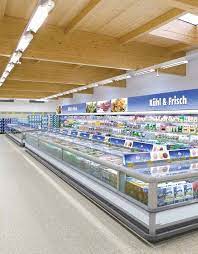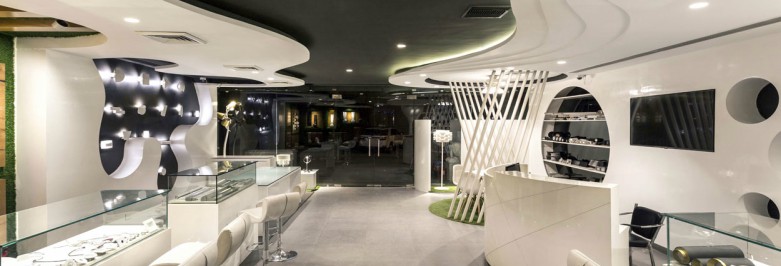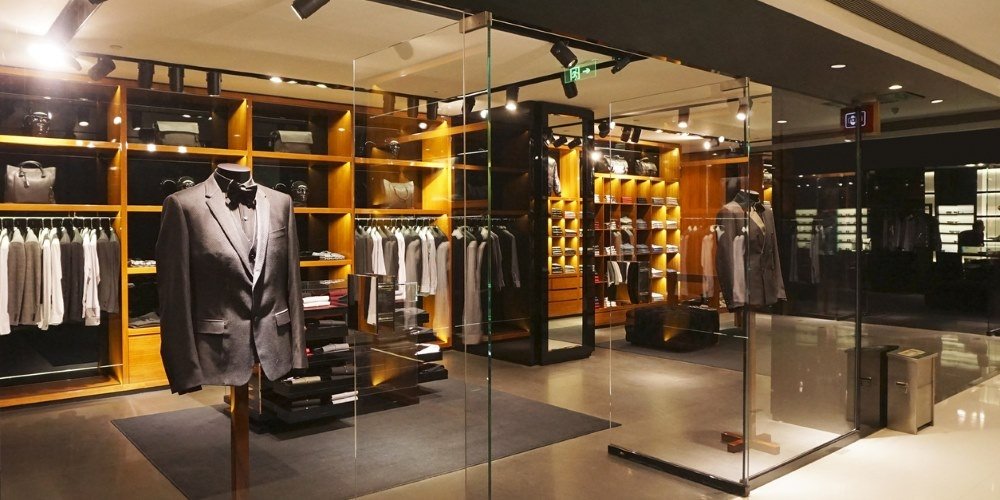Lighting is essential in drawing attention to merchandise in a display. A shopper’s eye is automatically fixed to the brightest item or area. Lighting treatment may be used to draw attention to part of the display area, a specific item in the display, or to coordinate parts of the total display area. Lighting can also be used to direct shoppers through the store, attracting them to various displays along the way. Because of this tendency to follow a lighted path, display lights should be two to five times stronger than lighting in other parts of the store.
There are three types of lighting used in store illumination: primary, accent, and atmosphere lighting.
Primary Lighting

Primary lighting is the overall level of illumination of the store using fluorescent or incandescent light sources. Outside, it includes 150-watt bulbs used as basic window lighting, marquee lights, illuminating the sidewalks, and lighting for the general lobby area. Inside the store, primary lighting is that which fills the selling floor from overhead lighting fixtures and provide the bare essentials of store illumination.
Accent Lighting
Accent or secondary lighting provides illumination for designated display areas. Flat, shadow-less, overall lighting can create a tiresome selling floor. Accent lighting provides change from light to dark or highlights to shadows, to prevent this boredom. This can be accomplished with down lighting from the ceiling, showcase lighting and valance (drapery or canopy) lighting. Incandescent bulbs are most often used for secondary lighting. They range in size from tiny Christmas tree lights to small candle-like or complexion bulbs, on up to full-size globe or reflector-type bulbs.
Spotlights are great for merchandise displays. An incandescent floor light can be used to illuminate lettering that identifies a store or a department within a store. A light and dark pattern can be created by highlighting the important parts of the display and letting the shadows create depth and pattern. Spotlights can be used on a larger scale to add excitement to merchandise shelves. Turning off the lights in the aisles on either side will allow the spotlighted areas to stand out even more.
Spotlights used in a display are installed either in the ceiling or on a track. These lights are surrounded by a cylinder, which affects the way light is emitted. When the spotlight is placed toward the back of the cylinder, the light is restricted to a smaller circle and therefore more concentrated. When the spotlight is placed toward the opening of the cylinder, there is less restriction and therefore a larger circle of light is emitted.
The angle at which a spotlight is directed is very important. Readjust the lights every time a new display is done, pointing spotlights at preselected items in the display and adjusting so passers-by do not catch the spotlight in the eye. Any angle sharper than 45° is likely to shortly blind a shopper.
Coloured filters that change the colour of light are available for spotlights. Filters most often used are pink for mannequin faces, amber for dramatic effects, straw to intensify warm colours, and daylight blue for icy feelings. Make sure the filters do not change the colour of the merchandise. Filters should be used to highlight backgrounds, props, faces and walls.
Gels are colour acetate that can be placed over light bulbs. They are similar to filters but are less expensive. Gels are available in rolls and can be cut by hand to fit a spotlight or to cover fluorescent tubes. Gels need to be replaced weekly.
High-Intensity Discharge (HID) lamps are the most efficient bulbs available because they provide more light per watt than either fluorescents or incandescent. The HIDs are relatively small in size and can also provide shadows and highlights as do the incandescent. All the major lighting companies have produced HID bulbs that emit a light that enhances the merchandise and is flattering to the customer. The reduction in energy costs overrides the expense of the light bulb itself.

Atmosphere Lighting
Atmosphere lighting is used to play light against shadow to create a distinctive effect on specific displays. Generally, this category includes the use of colour filters, pinpoint spotlights and black lighting to create dramatic effects.
Fluorescent lights are used for primary lighting, as they cannot be focused or directed toward a specific object. They wash an area with light in which no shadows or accents are made. A wide range of shades is available for enhancing the colours of the merchandise and the store.
For example, an ultrapure or prime colour fluorescent is available and strengthens the colours in skin tone and merchandise, so both look good. Colour fluorescent lamps, available in blue, green, cool green, gold, pink and red produce dramatic effects and coloured backgrounds. A cool white bulb gives a bluer feeling, the colour of snow, which can enhance a fur department display. A warm sunny bulb will create the opposite effect.
Be careful when using fluorescent lighting, as the overall store atmosphere may appear dull and boring. Avoid this by using a combination of lighting effects.
Incandescent lamps have sharply defined beams that are easily directed to highlight the merchandise on display. These are available in numerous sizes, shapes, wattages and colours. They do throw off a great deal of heat, however, which can be a fire hazard as well as increase the cost of air conditioning.

Click here to download a handout with suggestions for using light effectively.